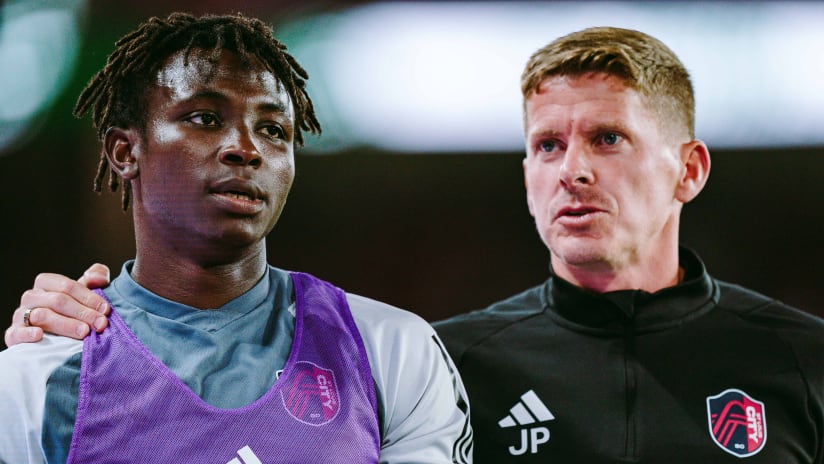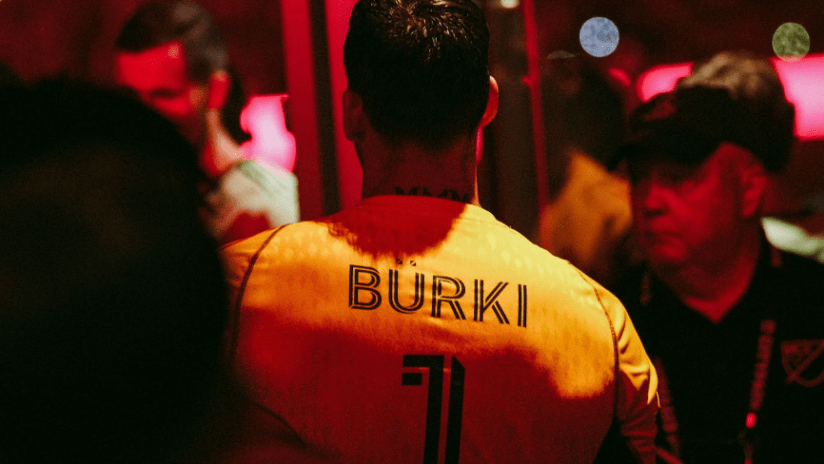Written by Michael Haffner
🇲🇽 Para leer en español, ver aquí. | 🇧🇦 Za čitanje na bosanskom, pogledajte ovdje.
Jarryd Phillips, Director of Sports Performance – Breaking Performance Barriers
When you break your leg twice by the age of 13, it leaves an impression on you. And when you break it while doing the very thing you love and hope to do for your entire life, it’s safe to assume the effects are even stronger.
Jarryd Phillips always wanted to be a professional soccer player. While he came up through a good academy system in South Africa which led to many of his old teammates still playing pro to this day, he was often sidelined with injuries throughout his playing career. Being injured created a desperation to get back to the level of his other teammates again… and again.
“I would be given physical therapy assignments to do three sets of 10 of a specific exercise, and I would go home and do about 10 sets.” He goes on to reveal, “I don't think any 13-year-old should be learning that stuff at that age.”
As a kid in the infancy of his playing career sitting in his bedroom doing leg raises, little did he know his self-motivation to get back to performing at his highest level would influence his entire life from then on.
“I was always intrigued by coming back from injuries. Getting stronger and overcoming the obstacles.”
From what he learned at a young age to his later years of coaching to now serving as the Director of Sports Performance at St. Louis CITY SC, he has used a lot of the very basic principles and ideas to help bring players back from injuries. How to get guys fitter and stronger in a more functional and dynamic way using a mix of objective data analytics and what he calls “football fitness.”
From Player to Coach to Sports Science
At the age of 19, Jarryd Phillips came to the U.S. from South Africa to play soccer at the University of Maine. It was as far north as you can practically go in the States, and the cold weather was an unwelcome change. Yet, he was among many others who were also far from home, hoping to live out their soccer dreams. It was a teamcomprised of South Africans, Jamaicans, Croatians, and Scotts. “It wasn’t uncommon to be playing with 20-year-olds or even 30-year-old players.” However, injuries continued to accumulate for Phillips – from leg injuries when he was younger, to his knees and hips in adulthood.
“One thing led to the next and you start seeing the guys going to the next level. Naturally, I just fell behind because of the injuries.”
At this point, Jarryd knew it was time for a professional change. Phillips got his first assistant coaching job while earning his master’s degree at the University of Mary. By that time, he found himself analyzing the game in ways that he calls a “practical soccer approach.” In between studying sports theory, he would try to implement better performance practices. When the school received a Polar Player Monitoring System, it piqued his interest. He went from reaching his new dream of being a soccer coach to now trying to wear the hat of a sports scientist or fitness coach. Even though, Jarryd admits that he didn’t know what he was doing at the start.
“I would run a training session and run off to the sideline and check the heart rates. Then run back and forth reading training sessions. That's basically how I started sort of delving into the fitness side of things.”
Phillips was then able to get his foot in the door at the Seattle Sounders as their Strength and Conditioning Coach in 2015. From there he moved to Minnesota United to focus on sports science where he established and directed all facets of the performance department for the first team and academy beginning in 2016.
After Minnesota, Jarryd worked a few more years with the New England Revolution as the Director of Sports Performance before joining fellow South African, Head Coach Bradley Carnell, in St. Louis. Here, he’s faced with a new set of challenges:
- Making sure the First Team is ready to play CITY’s high-pressing style.
- Ensuring that the team stays healthy as they strive to reach their goals.
To reach those goals, Jarryd employs a suite of technology and works closely with Kelly Roderick and the entire First Team staff. By tracking players and their performance, CITY can use data to make informed decisions that help keep players at their best.
The Cornerstones of Success
“There's no fitness like football fitness.”
It’s more than just a catchy phrase when Phillips says it. Talking with him is like talking to a well-studied philosophy professor. His thoughts on high-concept performance tactics and approaches to training flow so easily that a simple question provokes a profound 15-min response with not a pause in sight. His passion is in lockstep with his knowledge, working congruently – not aimlessly seeking or running for answers in his head.
“I can make you run as far and as hard as you possibly want. But then when it's your time to play in a game or a 6-v-6, you're gonna feel winded…you're gonna feel tired.”
What he’s speaking of and firmly believes in is training with SAID Principles. SAID –Specific Adaptations to Impose Demands – centers on the idea of your body adapting to certain exercises and movements over time through repetition and training.
“I want to make sure that they [CITY players] are able to perform the amount and quantity of basic soccer actions within a practice session that that they would find themselves doing on match day.”
He wants those actions to feel even easier than during practice sessions because they've done them before. Over and over again. Each practice is focused more on familiarizing players with the basic actions and movements they will be doing on match day – not just running for the sake of running.
“So, what makes us a high- or hard-pressing team? Speed. And what is speed? Speed is sprinting. But for us, sprinting is not just speed but also how many times we can perform those sprints. So the number that ultimately becomes more important to us is the amount we sprint, and the frequency of which we sprint: The sprint count. Because of our style of play and identity, we tend to run a lot anyways. But what we really want to see in an ideal game is to have high sprint count numbers.”
Despite the amount of work and pressure that this style puts on the players physically and mentally, Phillips admits he is most proud that the team has only suffered two soft-tissue injuries so far: João Klauss and Njabulo Blom. The team is now in week 20 at the time of writing this – including first day of camp and pre-season – and the team has managed to stay mostly healthy and avoid serious injuries. “We've done a pretty amazing job between the coaching staff, the performance staff, and medical staff with keeping these guys on the field and being able to perform the way they have.”
But the staff can only do so much. We talk about the other factors that the staff can’t always control, including effort and nutrition. The effort that’s needed to close down plays and not just jog up when pressing. As well as taking ownership of personal nutrition. Each player gets a regular body composition assessment to make sure they are under 10% body fat. When Phillips arrived last year, he saw several players teetering around 11-12%. Now, almost the entire squad is under 10%.
“We have a very young team. So for players of this age to be that calculated in what they are eating, you gotta give a lot of credit to the players for thinking about how they treat nutrition and micronutrients. They’re better when they go down to the gym. Taking better control of their bodies through movement patterns. They're asking about nutrition, about sleep, and more ways to improve as young professionals.”
There’s a sense of pride when he talks about not just the physical strength of the team, but also the mental and emotional strength of this young squad. How they are taking it upon themselves to improve their performance. They are self-motivated, and that’s something you can’t necessarily instill in a player. It’s a quality that Phillips knows personally, all too well.
Keeping Pace for the Road Ahead
One of the main questions many have echoed is how can a team that wants to be defined by an aggressive high-press maintain that for a full season, including additional Cup matches and what looks like a potential trip to the playoffs? Is that style of play sustainable?
Phillips talks about the balance of workloads. From “re-entry days” to “higher load days,” he’s not looking at the players in a comparative sense but rather making sure each player is delivering on their positional demands and hitting their individual demands. As he explains, “It doesn’t mean just because we lose the game that we're not running.”
With more than a decade of experience in the MLS, he knows how strenuous this league and season can be. It’s easy to get caught up in the emotions of seeing a player pining to get back out there after an injury. He recently saw it with Blom and Klauss. They both were itching to get back to playing as quickly as possible. Phillips understands this desire and drive. But he’s trying to look at the big picture of what's going on and make calculated decisions. As he states rather bluntly, Bradley Carnell hired him to help with the objective side of the game.
“I try to be neutral in terms of keeping emotional decisions out of the game. As the year goes on and as the results take over whether they are positive results or negative results, I’m looking at what's taking place, performance-wise, in a very objective way. That way, we can make appropriate, educated, objectively-based decisions as we go through the day-to-day and season.”
“I want the players to have the confidence that they are playing at the right technical and physical level. That they are making smart, positive decisions, giving them appropriate mental stimulation and challenges that they need to overcome. If the coach has confidence in that, then he feels good in a practice session, and the players will feel good. I think that there's a ripple effect to that.”
Throughout his injury-filled career, there was never someone that motivated Phillips to bounce back. Not a specific coach or mentor that pushed him to recover. It was all what he calls “internal motivation.” And while he believes this young team has the emotional intelligence and strength to provide that on their own, he can now be that voice he didn’t necessarily have. That voice you hear when times get tough. The one that tells you when it’s okay to push or to sometimes slow down and pause. While that voice is objective in its advice, it’s not void of compassion. It comes from a heart and mind that has been through similar challenges. The kind of challenges that leave an impression on you.
“I learned a lot as both a youth player and an older player later down the line. Then, to be able to take all those memories, the academic studies and everything, and put it all together as you evolve over time. It all comes together in one big picture. So it's kind of crazy. It's almost as if it was meant to be.”







